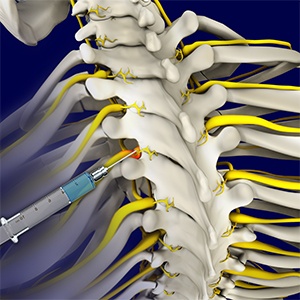
What Is a Nerve Root Block?
A nerve root block is a minimally invasive technique which assists in diagnosing the cause and providing treatment from pain resulting from nerve root irritation. It can be used to treat pain in the cervical, thoracic and lumbar spine.
What Conditions Are Appropriate for Nerve Root Block Treatment?
- Cervical Radiculopathy: Pain or altered sensation in upper extremity
- Lumbar Radiculopathy: Pain or altered sensations in the lower extremity.
- Bulging Intervertebral Discs: Structural alteration of intervertebral discs beyond their normal parameters.
- Herniated Disc: Migration of intervertebral disc usually into the area of the spinal cord and nerve roots.
- Arthritis: Degeneration of the spinal joints.
What Does the Treatment Involve?
The treatment involves injecting local anaesthetic and steroid around a specifically targeted nerve root of the spine. We usually do these under image guidance using Computed Tomography (CT) which enables us to ascertain the most accurate anatomical target for the treatment.
How Are Nerve Root Procedures Performed?
The procedure usually takes 30 minutes. During this time, you are typically required to lie in the prone position. We will take an initial scan to plan the injection route. A local anaesthetic is instilled into the skin prior to the subsequent injection which will target the nerve root. Small selective scans will be performed during the nerve root block procedure to ensure the target trajectory and target is optimum.
What Are the Benefits of a Nerve Root Block?
When a nerve root becomes irritated it can cause significant pain and disability in the region which it supplies. This can affect the upper or lower spinal regions. Selective nerve root block has two main benefits, firstly it provides pain relief and also it confirms the underlying cause of the pain which is essential in streamlining future treatment if required.
What Preparation Is Required?
You will need to arrange transport to and from your appointment. As the treatment can affect your ability to drive on the day it is important that you refrain from driving on the day of the injection.
It is important that you inform the Radiologist if you are on treatment for any other medical conditions or have any allergies.
Success Rates of Nerve Root Blocks
If your pain subsides after the injection it is an indication that the doctor has identified the cause of your pain however often it can take some time after the injection before its benefits can be experienced. It is not uncommon for pain to reoccur for a few days post-injection, this can be attributed to the anaesthetic wearing off prior to the steroid taking full effect.
Risks and Complications of Nerve Root Blocks
- It is common following a nerve root block to feel some local pain in the injection site, light-headedness and nausea are also common.
- Infection, bleeding and allergic reactions are rare side effects.
- Serious complications in nerve root blocks in the upper spine include stroke and paralysis however these are very rare. It is important that these procedures are carried out by experienced specialists.
